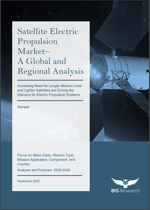 Low Earth orbit (LEO)-based missions are vulnerable to severe orbital decay as compared to those in higher orbits, so efficient propulsion capability for station-keeping remains a critical element for these missions.
Low Earth orbit (LEO)-based missions are vulnerable to severe orbital decay as compared to those in higher orbits, so efficient propulsion capability for station-keeping remains a critical element for these missions.
The path to the Moon, Mars, and beyond requires a fleet of spacecraft of various shapes and sizes, including massive rockets that produce millions of pounds of thrust and pioneering small electric propulsion thrusters that can fit easily in smaller spaces.
Since small satellites impose the need for smaller and lighter hardware, electric propulsion systems present a suitable option. However, electric propulsion systems are of low-thrust nature as compared to chemical propulsion systems, and this is driving the uptake of the higher volume of electric propulsion systems.
The development of high-thrust variants of electric propulsion systems is resulting in the uptake of electric propulsion systems for orbit-raising applications as well.
Role of Electric Propulsion in LEO Satellites
Particularly with the growing number of small satellite constellations being launched, the propulsion systems are responsible for station keeping, orbital positioning, insertion, and attitude control. Therefore, they have a very crucial role in the space industry.
The electric propulsion systems enable extended mission lives, driving the operators to consider electric propulsion for their satellites. Electric propulsion is also gaining popularity in the geostationary Earth orbit (GEO) category. Satellite operators are using all-electric satellite platforms to reduce the mission cost, take more payloads to orbit, and increase the mission lifetime.
Increasing Deployment of Electric Propulsion in LEO Missions
Due to the miniaturization of satellite electric propulsion systems, and standardization requirement for serial production, electric propulsion systems are being deployed in large volumes across multiple missions, which demand smaller and lighter satellites.
Hence, small satellites in the low Earth orbit constitute the demand for electric propulsion systems for orbital maneuvers such as orbit raising, station keeping, and de-orbiting at the end of life.
Several satellite companies showed significant interest in electric propulsion systems during 2020-2021. This resulted in rapid growth owing to the increasing requirement of launching satellite constellations for communication and Earth observation.
Satellite electric propulsion technology companies have witnessed major demand from the growing commercial industry. In response to this, the satellite electric propulsion market ecosystem comprises system manufacturers, original equipment manufacturers (OEMs), and end users
According to the BIS Research report, the global satellite electric propulsion market is estimated to reach $1.02 billion by 2032 from $522.3 million in 2021, at a growth rate of 4.10% during the forecast period.
Recent Developments in the Satellite Electric Propulsion Market
Between 1957 and 2021, many governments and commercial organizations, such as Ariane Space, Europe Space Agency (ESA), the National Aeronautics and Space Administration (NASA), and Japan Aerospace Exploration Agency (JAXA), started demonstrations for the new propulsion system for different satellites in LEO missions.
Since then, technology has evolved continually and transformed the entire space industry by developing unique products and systems.
- In April 2021, Norwegian Space Agency selected ThrustMe to provide NPT30-I2 electric propulsion for the NorSat-TD mission. This company was responsible for providing collision avoidance maneuver capabilities to the NorSat-TD satellite with its iodine propulsion system.
- In August 2021, to enhance the orbital transport and maneuver capability, Neutron Star Systems (NSS) and Bradford Space signed a cooperative agreement.
- In June 2022, Safran signed a contract with Thales Alenia Space to supply its PPS 5000 plasma thruster for Thales's Galileo satellites.
- In July 2022, a contract of $2.4 million was received by Thales Alenia Space from European Space Agency (ESA) to develop Skimsat, a small satellite bus for very low Earth orbit (VLEO).
Conclusion
While all-electric platforms are being chosen by most GEO satellite operators for their new missions, replacement phases of existing missions, weight, and volume constraints are driving small-satellite operators to still choose electric propulsion over chemical propulsion.
This does not indicate the end of the road for chemical propulsion, but access to a wide range of lighter electric propulsion capabilities is driving the migration from chemical to electric propulsion while altering the ratio of electric vs. chemical propulsion on satellites.
Electric propulsion is now being deployed for applications that traditionally relied on relatively high-thrust chemical propulsion systems with their improving scalability in LEO missions.
Learn More
 For more information about this fast-growing market, please see Satellite Electric Propulsion Market - A Global and Regional Analysis, a 149-page report packed with data and insights covering market segmentation, recent market developments, market demand, drivers and challenges, the competitive landscape, and key players. The report provides valuable data-driven market intelligence to help organizations and corporations develop strategies for product innovation, sales growth and marketing, and competitive benchmarking and positioning.
For more information about this fast-growing market, please see Satellite Electric Propulsion Market - A Global and Regional Analysis, a 149-page report packed with data and insights covering market segmentation, recent market developments, market demand, drivers and challenges, the competitive landscape, and key players. The report provides valuable data-driven market intelligence to help organizations and corporations develop strategies for product innovation, sales growth and marketing, and competitive benchmarking and positioning.
About the Publisher: BIS Research is a global market intelligence, research and advisory company that focuses on emerging technology trends that are likely to disrupt the market. Its team includes industry veterans, experts, and analysts with diverse backgrounds in consulting, investment banking, government, and academia.

